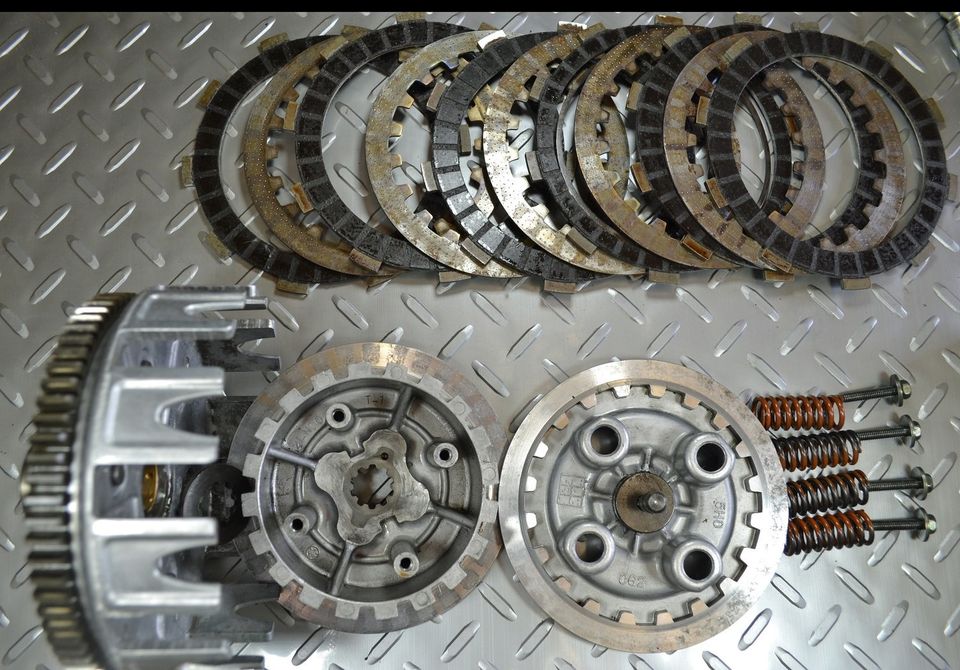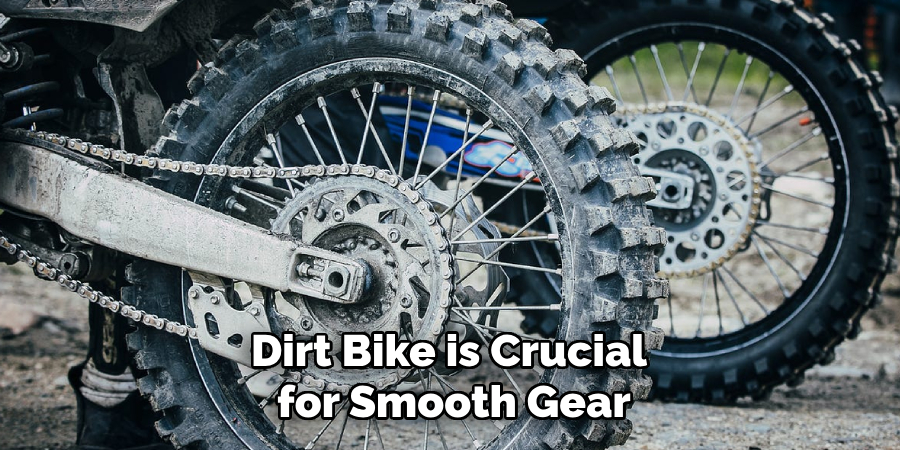The clutch on a dirt bike works by transmitting power from the engine to the transmission, allowing the rider to shift gears and control the bike’s speed. When the clutch lever is pulled, it disengages the clutch plates, allowing the engine to idle freely without transferring power to the transmission.
Releasing the clutch lever engages the clutch plates, connecting the engine’s power to the transmission, which then drives the bike forward. This mechanism enables the rider to start the bike from a standstill, change gears smoothly, and have better control over the bike’s acceleration and deceleration.
Mastering clutch control is crucial for off-road riding and performing tricks on a dirt bike.

Credit: www.rrrtoolsolutions.com
How Does a Clutch Work on a Dirt Bike: Step by Step Guide
Understanding The Basics
Understanding the basics of how a clutch works on a dirt bike is essential for any rider. Let’s start with what a clutch actually is. The clutch is a mechanical device that allows the rider to engage or disengage power from the engine to the transmission. It consists of several parts, such as the clutch lever, clutch plates, clutch hub, pressure plate, and clutch basket.
The clutch lever is what the rider uses to control the clutch. By pulling the lever in, the clutch plates are pressed together, allowing power to be transferred from the engine to the transmission. When the lever is released, the plates separate, disengaging the power.
The clutch plates themselves are made up of friction and steel plates. When squeezed together, the friction plates create enough friction to transfer power. The clutch hub, pressure plate, and clutch basket work together to hold the plates in place and provide stability.
Understanding how these different parts work together is vital for a smooth and efficient riding experience. So the next time you hop on your dirt bike, you’ll have a better understanding of how the clutch functions.
The Clutch Engagement Process
The clutch engagement process on a dirt bike is crucial for smooth gear shifting and control. The clutch lever plays a vital role in engaging the clutch. When you pull the clutch lever towards the handlebar, it disengages the clutch plates. As a result, power from the engine is disconnected from the transmission, allowing you to shift gears without resistance. When you release the clutch lever, the clutch plates come back into play, connecting the engine power to the transmission. This enables power transfer and propels the bike forward.

The mechanics of the clutch hub and pressure plate interaction are also important. The clutch hub is connected to the engine’s crankshaft and rotates with it. The pressure plate exerts pressure on the clutch plates, keeping them engaged or disengaged depending on the clutch lever’s position. The clutch basket, on the other hand, houses the clutch plates. It provides support and helps in transferring power between the clutch hub and the transmission.
Understanding how the clutch works on a dirt bike is essential for mastering gear changes and achieving optimal performance.
Clutch Operation And Power Transmission
The clutch on a dirt bike is a crucial component that enables the efficient operation of the power transmission system. It works by engaging and disengaging the power from the engine to the transmission, allowing for a smooth transition of torque to the rear wheel. When the clutch is engaged, power is transferred from the engine to the transmission, enabling the bike to gain momentum. However, if the clutch slips or overheats, it can lead to performance issues and potentially damage the clutch assembly.
During clutch engagement, the power from the engine is transmitted through the clutch plates, which are pressed together by the clutch springs. This creates friction and allows for the transfer of torque to the transmission. The transmission then further amplifies the torque and delivers it to the rear wheel, propelling the dirt bike forward. It’s important to maintain the clutch system to ensure optimal power delivery and avoid any potential damage.
| Clutch Operation | Power Transmission |
|---|---|
| – Engages and disengages power from the engine | – Transfer of torque to the transmission |
| – Potential issues with slipping and overheating | – Power delivery to the rear wheel |
Maintenance And Troubleshooting
- Essential maintenance tips to keep your clutch in optimal condition: Regular maintenance is crucial for ensuring the proper functioning of your dirt bike clutch. Here are some important tips to keep in mind:
- Watch out for signs of clutch wear and potential issues: Pay attention to any strange noises, vibrations, or difficulty in shifting gears. These can indicate a problem with your clutch.
- Common clutch problems and how to troubleshoot them: Two common issues are a slipping clutch and a dragging clutch. If you experience a slipping clutch, check the clutch cable tension, and if necessary, adjust it accordingly. For a dragging clutch, make sure the cable is properly lubricated and not too tight.
- Clutch not disengaging: If your clutch fails to disengage, start by checking the clutch cable for any kinks or damage. Ensure that the cable is correctly adjusted and lubricated. If the problem persists, it may be necessary to inspect and potentially replace the clutch plates.
By following these maintenance tips and promptly addressing any clutch issues, you can optimize the performance and lifespan of your dirt bike’s clutch.

Advanced Clutch System Features
Modern dirt bikes feature advanced clutch systems that offer enhanced control and performance. These systems incorporate innovative technologies to optimize the rider’s experience while overcoming the challenges of off-road riding.
One notable advancement is the introduction of hydraulic clutches, which provide a smoother and more consistent clutch engagement. Unlike traditional cable-operated clutches, these systems utilize hydraulic fluid to transfer power, resulting in a more precise and responsive clutch control.
Adjustable clutch engagement points offer another significant benefit. This feature allows riders to customize the clutch’s engagement to their specific preferences and riding conditions. By adjusting the engagement point, riders can achieve optimal power delivery and avoid unnecessary clutch slip or stalling.
Dual-clutch systems take clutch technology to the next level. By integrating two separate clutch assemblies, these systems enable quick and seamless gear changes without interrupting power delivery. This results in faster acceleration and enhanced handling capabilities, especially in high-performance dirt bikes.
Enhancing Clutch Performance
A clutch is a vital component in any dirt bike, and understanding how it works is crucial for optimizing its performance. Enhancing clutch performance can greatly improve the overall riding experience. Aftermarket upgrades provide an opportunity to enhance clutch durability. Upgrading clutch plates with different materials can have a significant impact on performance, providing more control and better engagement. Choosing the right clutch spring tension is another important factor in clutch performance.
Adjusting the tension allows for precise engagement, resulting in smoother shifts and better responsiveness. Furthermore, optimizing clutch performance in various riding conditions is key. Adjusting the clutch for different terrain, weather, and riding styles can help ensure maximum efficiency. So, whether it’s upgrading clutch components, adjusting spring tension, or optimizing for specific riding conditions, enhancing clutch performance is essential for all dirt bike enthusiasts.
Frequently Asked Questions Of How Does A Clutch Work On A Dirt Bike
Are You Supposed To Use The Clutch On A Dirt Bike?
Yes, the clutch is essential for controlling the power and speed on a dirt bike.
Do You Hold Clutch While Shifting On A Dirt Bike?
Yes, you should hold the clutch while shifting on a dirt bike.
How Do I Know If My Dirt Bike Clutch Is Worn Out?
To check if your dirt bike clutch is worn out, look for slipping or erratic engagement while shifting gears.
How Does A Clutch Work On A Dirt Bike?
A clutch on a dirt bike allows the engine to disengage from the transmission temporarily, enabling you to change gears without stalling the engine. When you squeeze the clutch lever on the handlebars, it separates the clutch plates, interrupting the power flow from the engine to the gearbox.
Conclusion
Understanding how a clutch works on a dirt bike is crucial for any rider. A properly functioning clutch allows for smooth gear shifts, providing control and power. As we’ve learned, a clutch is essential for engaging and disengaging the engine with the transmission, allowing the rider to control speed and power.
Through a combination of friction plates, pressure plates, and springs, the clutch transfers power from the engine to the transmission, enabling smooth acceleration and deceleration. Proper clutch technique, such as feathering and modulating, can enhance the riding experience and prevent unnecessary wear on the bike.
Regular maintenance and proper adjustment of the clutch are also important to ensure optimal performance. By understanding how the clutch works and practicing good riding habits, dirt bike enthusiasts can maximize their enjoyment and performance on the trails. So, next time you hit the dirt, feel confident in your knowledge and skill when it comes to working that clutch!

